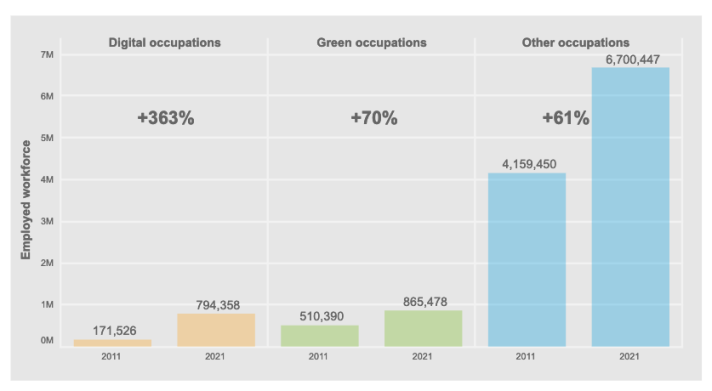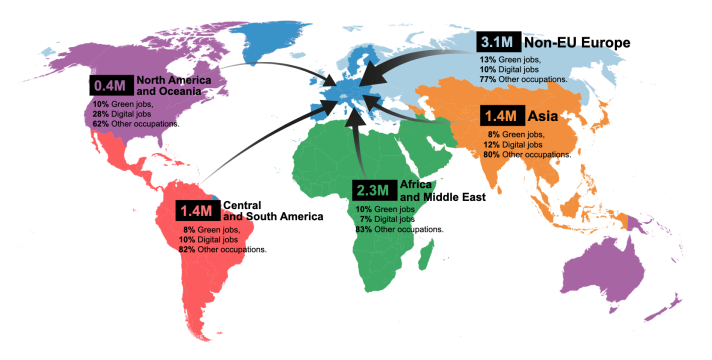
Skills shortages persist across the EU, in a range of sectors, and at various skills' levels. To address them, the EU will also need to attract skills and talent from all around the world.
A JRC analysis shows that third country nationals (TCNs) employed in the EU are increasingly filling important gaps in occupations persistently affected by a shortage of workers. In 2021, while the share of third country nationals in the EU27 workforce is 4.4%, it increases to 7.1% when considering the 14 occupations that have endured a labour shortage since 2016.
The analysis focuses on data from 2021, and investigates developments since 2011. Looking at the overall distribution of non-EU workers in the EU labour market in 2021, non-EU workers make up 2.7% of digital occupations, 4% of green and 4.9% of other occupations. The green and digital occupations are defined using a task-based approach, calculating the share of green or digital tasks and setting a minimum threshold. The “other occupations” include domestic, hotel and office cleaners and helpers, shop salespersons, and care workers in health services.
These shares remain low at EU level despite a nearly quadruple (363%) increase of non-EU workers in digital occupations and 70% increase in the green sector. With targeted policies such as targeted training and skills development programmes for migrant workers in green and digital jobs, the facilitation of the recognition and validation of qualifications and work experience, and greater opportunities for migrant entrepreneurship in the green and digital sectors participation rates can further increase, improving their integration in the EU economy.
Looking at EU labour needs up to 2035, elementary occupations and high-skilled non-manual occupations are projected to face the strongest shortages. In particular, according to the annual Employment and Social Developments in Europe (ESDE) review, the Commission foresees 22 broad categories of shortage occupations, of which eight have a high green or digital task content. The Commission’s Action plan to tackle labour and skills shortages, the European Skills Agenda and the Pact for Skills, launched to address labour shortages, include a series of initiatives on improving and gaining new skills, activation and work incentives, and working conditions.
The largest share of non-EU workers – roughly 38% – originates from European countries beyond the EU, followed by Africa and the Middle East (27%). Europeans from non-EU countries also account for the largest share of jobs held by third country nationals across digital, green and other occupations as defined in the JRC analysis, possibly due to geographical proximity, visa regimes and cultural similitudes.
Germany, Italy, Spain and France – EU’s four most populous countries – host about 6.6 million non-EU workers, equivalent to 79% of all third-country nationals employed in the EU. Germany alone absorbs about a third (2.4 million people) of the non-EU workforce. This absorption capacity could among other factors be explained by the rate of population ageing, as Germany, Italy and Spain are among the fastest ageing countries in the EU.
The four EU countries also employ the largest numbers of non-EU nationals in digital and green jobs. About 28% of all non-EU workers in the green sector and about a third of those in the digital sector, are employed in Germany. The Netherlands, Ireland and Sweden also attract a significant number of non-EU nationals in their digital sector, possibly due to the importance of this sector in their economies.
The origin country perspective: how does the emigration of talent impact countries of origin?
Migration is often perceived through a single-sided ‘brain drain – brain gain’ narrative, which is focused on skilled professionals who move from their home countries in search of better economic prospects. This narrative suggests a loss for countries of origin as they give up their brightest minds to the global workforce.
Another JRC science for policy brief challenges this perspective, highlighting a more nuanced reality, where migration can catalyse a boost in human capital and sustainable development. The brief explores the multifaceted implications of talent migration and highlights the various positive feedback mechanisms of talent emigration that can foster economic and human development in countries of origin.
Migration is skill-selective, which means that the propensity to emigrate is much higher for the high-skilled than for the low-skilled. Consequently, over the past 30 years, the average global emigration rate of college graduates amounted to approximately 5%, while about 1.5% of the less educated were emigrants. This difference is even more pronounced in low-income countries, where the high-skilled emigration rate was around 18 times higher than the low-skilled one.
Migration can stimulate a beneficial additional skill formation in most countries of origin. Furthermore, the migration of the high-skilled also brings positive feedback mechanisms, such as facilitating trade and foreign direct investments or raising income levels via financial remittances.
Legal migration plays a key and complementary role in supporting the labour market needs of the EU, and also in enhancing migration management, fostering cooperation with countries of origin and transit, and ultimately contributing to the reduction of irregular migration.
The Pact on Migration and Asylum – now in force – reflects a comprehensive and a whole-of-route approach to migration management. Therefore, the Commission is pursuing with the Member States a two-track approach, accompanying legislative work at EU level with operational activities. This notably includes work on the external dimension of migration, through the pursuit of comprehensive partnerships with partner countries.
Developing labour migration cooperation with third country partners, supported by common EU legal migration rules and alternative pathways for those in need of international protection, provides for a balanced approach to migration.
Benefits come not only in terms of sound migration management but also through remittance flows and the transfer of skills and knowledge to partner countries. An active policy to make the most of labour migration in Member States makes a major contribution to addressing labour market shortages. Improving labour migration governance, education and vocational education and training systems, and joint approaches to the recognition of qualifications and skills, are essential elements to promoting skills as a driver for economic growth, to the mutual benefit of the EU and its partners.
The EU Talent Pool will also contribute to fair labour migration, as the first EU-wide platform facilitating international recruitment with built-in safeguards to avoid exploitative and unfair practices and informing job seekers in third countries about opportunities to work in shortage occupations in the EU at all skills’ levels. The fast operationalisation of the tool relies on swift adoption of the legal framework by the European Parliament and the Council.
The Commission is also implementing measures set out in the Skills and Talent Mobility package of November 2023 to support the validation of skills and recognition of qualifications gained outside the EU, which remains an obstacle to migrant recruitment and labour market integration. The Commission will continue engaging with Member States and social partners through the Labour Migration Platform, which facilitates cross-sectoral discussions on practical issues.
Related links
The contribution of Third Country Nationals to the twin transition in the EU
Migration of Talent: Implications for Countries of Origin
Details
- Publication date
- 12 June 2024
- Author
- Joint Research Centre
- JRC portfolios






